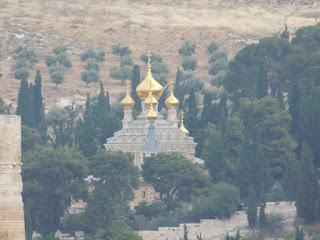The church takes its name from the Latin word "Gallicantu", meaning cock's-crow.[1] This is in commemoration of Peter's triple rejection of Jesus "... before the cock crows twice." (Mark 14:30)
The Word for both Cock's crow and the Watchmen blowing his trumpet at every watch is Gallicantu so Peter could have denied the :LORD between the 3rd and 4th watch. this is a possibility because Iam told that the Jews wont rear Cock which is considered unclean.
A Byzantine shrine dedicated to Peter's repentance was erected on this spot in 457 AD, but was destroyed by the Fatimid caliph Al-Hakim bi-Amr Allah in 1010. The chapel was rebuilt by Crusaders in 1102 and given its present name.
The entrance to the church is from a parking lot which is located above the main level of the church. In the courtyard is a statue that depicts the events of the denial and include its main figures; the cock, the woman, and the Roman soldier. The inscription includes the biblical passage; But he denied him, saying "Woman, I know him not"! (Luke 22:57)
The entrance itself is flanked by wrought iron doors covered with biblical bas reliefs.
Engraved art work on door (“I tell you, Peter, before the rooster crows today, you will deny three times that you know me.” Luke 22:34)
To the right are two Byzantine-era mosaics found during excavation, these were most likely part of the floor of the fifth-century shrine.
. Facing the entrance is a bound Jesus being questioned at Caiaphas' palace;
on the right Jesus and the disciples are shown dining at the Last Supper;
Altar in the Chappel
and on the left Peter, considered the first Pope, is pictured in ancient papal dress. (remember pope inthose days a over seer and Iam sure Peter the fisherman never wore these pompous dress)
Beneath the upper church is a chapel which incorporates stone from ancient grottos inside its walls.
you can see the cross if you carefully look
On an even lower level there is a succession of caves from the Second Temple period.
These are the caves under the church, dated to the 2nd temple period.
Since tradition places the palace of Caiaphas on this site, many believe that Jesus may have been imprisoned in one of these underground crypts after his arrest,
These underground caves were normal in many Roman-era homes, and often served as cellars, water cisterns, and baths
On the north side of the church is an ancient stepped stone paved street , on which you can walk down towards the valley of Kidron. A section of 100m were uncovered here, running west to east, with remains of Roman and Byzantine periods. This stepped way may have led down to the Byzantine church of the Shiloah pool. The stepped street may have also served as a passage from the upper city to the lower city during the second temple period.
This may have been a passage from the upper city to the lower city during the first temple period. Many Christians believe that Jesus followed this path down to Gethsemane the night of his arrest.
The stepped paved street crosses another north-south paved street, where remains of buildings, covered channels and caves were also unearthed. All around the yard of the church are many of the ancient buildings from the different periods in Jerusalem's history.
The excavations, conducted in 1888 by Germer–Duran, revealed the stepped road, the Byzantine church, Byzantine roads and houses, a rock-hewn bath house, and parts of the aqueduct.
This picture will give you an idea of how the church is built on an earlier structure
This is the field of Aceldama or Akeldama (Aramaic: חקל דמא; field of blood) is the Aramaic name for a place in Jerusalem associated with Judas Iscariot, one of the followers of Jesus.
A view of the Acaldema Monastery
The Following Pictures (Taken from the Church premises) will give a View of the Old City and will show how all the events of Jesus Arrest ,Crucifixion and Resurrection happened in close proximity
View of the Churches on the Mount of Olives
View of the Russian Church
The Valley





















































No comments:
Post a Comment